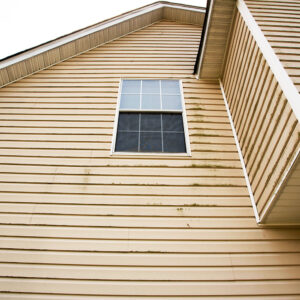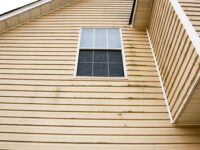Siding Repair: Why You Need to Have Your Siding Repaired
Siding is one of the most popular home renovation projects and can drastically increase your property’s value. But over time, weather, pests, and other factors can cause damage that requires Charleston Siding Repair.
Small holes can be fixed with epoxy putty that can be stained or painted to match the surrounding material. If the hole extends through to the underlying tar paper or house wrap, use spray foam sealant to fill the gap and cut away any excess after it cures.
While vinyl siding has been known to last from two to four decades, it can be susceptible to cracks and gaps that expose your home to the elements. These problems can be more serious than aesthetic, as they could allow water to seep through the panels and damage your home’s structural integrity. In addition, if the gap becomes large enough, it could let in moisture and eventually lead to dry rot, which is dangerous for your family.
Fortunately, there are ways to repair your vinyl siding’s cracks and gaps so that you don’t have to worry about the safety of your home or its structural stability. If the cracks are small, you can typically use a caulking gun to apply a waterproof sealant. You should apply a generous bead and slightly overfill it, then smooth the area with a putty knife. After the caulk has dried, you can paint it so that it blends with the surrounding siding color.
If the cracks in your vinyl siding are too deep to be repaired with caulk, you will need to patch them. This is a more involved process, but it will allow you to cover the cracks and make them look as though they never existed. To patch a hole in vinyl siding, you will need to find an inconspicuous spot and cut a piece of scrap siding that matches the color of your existing siding. You will then need to remove the old fasteners from the section that was damaged using a zip tool or pry bar. Once the old fasteners have been removed, you can use the patch piece to replace the damaged section of your vinyl siding.
Holes
A small hole in your vinyl siding may not seem like a big deal, but it could be an indicator that you have an unwelcome visitor living in your walls. Small holes in the lower part of your vinyl can indicate a woodpecker, and smaller ones higher up or near your roofline may suggest that a bird is building a nest inside your walls. Larger holes, particularly those closer to your door or window, can indicate that rodents such as raccoons, opossums, squirrels, and skunks are nesting in your walls.
You can repair holes in your vinyl siding using exterior caulking or a vinyl patch kit. For holes less than an inch in diameter, you can usually use caulk that matches the color of your siding to fill the hole. Apply the caulk with a putty knife and smooth it down to eliminate air bubbles or creases. Allow the caulk to dry completely before sanding it smooth and applying a coat of paint that matches the color of your siding.
For larger holes, you’ll need a backing material to give the patch something to adhere to. A strip of wood or scrap of vinyl siding can do the trick, but you may also choose to use a construction adhesive such as DAP Dynagrip Heavy Duty MAX Construction Adhesive. Before you put the backer in place, make sure to clean the area around the hole and remove any debris.
Once the backer is in place, you can use a siding zip tool to unlock the section of damaged vinyl and pull it away from the rest of the wall. This will reveal the nails that hold it in place, and you can use a pair of wire cutters to cut off the top and bottom rolled edges at both ends.
Once the edges are cleaned and dry, you can install a vinyl patch piece. Find an inconspicuous spot and remove a two-foot section of the damaged siding to make room for the patch piece. Cut the patch piece to size, and then apply it over the hole.
Gaps
Gaps in your siding can cause water to seep in and damage the interior of your home. These gaps also provide the perfect environment for mold and mildew growth, which isn’t good for your home or your health. If left untreated, these gaps can lead to rot and structural damage to your home’s exterior.
The good news is that if you catch these problems early, they’re easy to repair. Most of the time, all you need to do is apply a little caulk to seal up these small areas of your house’s siding. You can find matching caulk at most hardware stores, and you can paint over the caulking after it’s dried to hide it from sight.
Another way to fix these gaps is to remove the piece of siding that’s separating and replace it with a full-length panel of the same design and style as the surrounding pieces. This is a great option if you’ve got leftover pieces from the last time your home was sided or if the previous owner had the foresight to save these panels in a garage rafter.
Before you do anything, make sure to clean the area with a sponge and soapy water and allow it to dry completely before continuing the repairs. It’s also a good idea to put on your rubber gloves for this type of project because you’ll be working with wood and may encounter splinters or loose paint.
To begin, locate the gap and identify the cause of it. It could have been caused by a harsh weather event or by the installation of the siding. If the problem was due to poor installation, you’ll want to look at other sections of your home for similar issues.
Gaps like this can often be caused by product shrinkage after installation or by a combination of air drying and warm sunlight causing the siding to expand. This expansion can crush tight butt joints, resulting in unsightly gaps. This is especially common with fiber cement siding that’s nailed too high and starts to sag over time.
Leaks
Moisture damage behind siding can be a serious issue, and it’s one that can easily slip under the radar. It isn’t as apparent as physical damage or fading, but it can have just as much of an impact on the health and energy efficiency of a home. If moisture seeps through for an extended period of time, it can encourage the growth of mold on the foam board insulation sheets between your walls. This development poses a significant threat to your health, particularly for those with asthma and the elderly.
A professional can inspect and diagnose the source of your moisture problems, but there are a few things you can do in the meantime to help prevent further damage. For example, grab a caulking gun and fill any cracks, sunken nail holes, or other areas where water might enter your siding. Paintable caulking is ideal for these types of situations, as it allows the caulk to blend in with your siding and create a water-tight seal.
Another great way to protect your siding is by using rainscreen. This is a strip of pressure-treated plywood that runs vertically between your siding and a waterproof surface. This allows air to circulate, helps walls breathe, and reduces the amount of moisture that builds up behind your siding.
Leaks are another common problem for siding, and they can be difficult to identify unless you know what to look for. In this video, This Old House general contractor Tom Silva demonstrates how to check for leaks behind vinyl siding.
Start by checking for moisture damage around windows and doors, as well as where the soffit meets the roof edge and the wall meets the soffit. If any of these areas show signs of moisture, then it’s likely that the flashing and caulking were not installed properly.
The most obvious sign of a leak is water stains on the exterior of your home. In addition to being unsightly, water stains can indicate the presence of mold or mildew. Mold and mildew are threats to the health of your family, so it’s important to remove them as quickly as possible. If you notice these stains, then it’s a good idea to set up an appointment with a siding repair expert as soon as possible.





